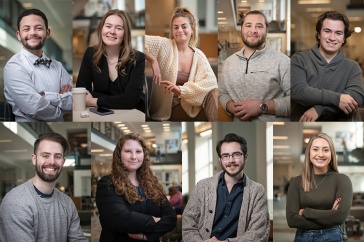Goblins, ghosts, werewolves, witches.
 |
At this time of year, those words conjure images of Halloween and favorite scary stories.
For one member of the UNH faculty, however, research into the folklore and fears of the past has also shed light on some of the issues of classism, racism and hate mongering making headlines today — and attracted the attention of Smithsonian.com.
Jorge Abril Sánchez, a lecturer in Spanish in the department of languages, literatures, and cultures, was contacted over the summer by a Smithsonian reporter to share his expertise for an article on the Basque country in Spain, the site of the largest witch trial in world history.
Abril Sánchez teaches courses on Spanish language, culture, civilization and literature, and his scholarly interests and research include the study of legends in the Middle Ages; heresy, folklore and treatises of demonology in Renaissance Europe; and the interconnections between church and state during the religious persecutions of the 16th and 17th centuries in Europe and the American territory.
Chatting in his office, surrounded by student art created during his courses that delve into issues of folklore and demonology through the literature of such authors as Cervantes, Abril Sánchez explains what happened in the Basque country of Spain over a five-year period in the early 1600s.
More than 7,000 people were accused of witchcraft, at least 2,000 were “examined” — with many of those investigations involving torture — and 11 lost their lives.
“I grew up hearing stories as part of the culture,” says Abril Sánchez, adding the power of those stories of witches, ghosts, monsters, werewolves — and a fear of “the other” — is not something relegated to 17th-century Spain.
At the time of the trials, anyone who contradicted the orthodoxy of the church or criticized the king for his military campaigns was fair game for accusations of witchcraft.
In Basque country, there was added incentive as the area, which encompasses parts of northern Spain and southern France, has a native language that does not draw its roots from the Germanic or Romance languages of the rest of Europe. “It has some similarities to Sanskrit,” Abril Sánchez explains, adding, “Anyone who challenged the orthodoxy by speaking a language that was not the mainstream language was persecuted.”
Among the accused was Inesa Gaxen, who is featured in the Smithsonian article: “After she escaped the witch trials in France, she fled to Spain and fell victim to them again in the Basque country,” the report states.
“The poor woman had to go through a trial twice,” Abril Sánchez told Smithsonian. “She was first accused of witchcraft in France. She went to trial and was pardoned by the Catholic Church. But then she moved to the Basque country and she was accused of witchcraft again there.”
Abril Sánchez explains she would ultimately survive her imprisonment.
In the United States, talk of witch trials almost always leads to 17th-century Salem, Massachusetts, and Abril Sánchez confirms there are some similarities between what happened in Salem and what happened in Spain. In both instances, children played a key role, with many manipulated to retaliate against familial enemies. And, in Spain and Salem, anyone who did not fit the mold of the ruling religion or government was at risk for persecution.
There were differences, however. "These things resonate today. The value of liberal arts courses is to make our students think critically."
In Spain, he notes, there were defenders within the church who were skeptical about the accusations. Of the more than 7,000 accused, six were killed while five died in jail before all 11 were eventually pardoned — compared to Salem, where 20 people of the 200 accused were killed.
Abril Sánchez says one of the most surprising things he has found in his research is the detail in the documents: from ridiculous accusations — even dead women could be charged for tempting living men — to the descriptions of the charges themselves. And he believes that studying the history of the fears that spurred the witch trials is important.
Next fall, UNH students will be able to delve into a new course from the department of languages, literatures and cultures that will explore the topics of demonolatry, demonology, Satanism and witchcraft from their origins in the Bible and classic works to modern times and from countries including France, Germany, Portugal, Russia and Spain.
“These things resonate today,” he says, pointing to the headlines that describe hate-mongering tactics against specific groups as the modern equivalents of witch-hunts. “The value of liberal arts courses is to make our students think critically.”
Learn more about the offerings in COLA's department of languages, literature and cultures.
-
Written By
Jennifer Saunders | Communications and Public Affairs



















































